The Olympic And Paralympic Museum In Colorado Springs Offers Inclusive Hope In A Time Of Darkness
"The stories of our Olympians and Paralympians are the stories of this nation’s history."
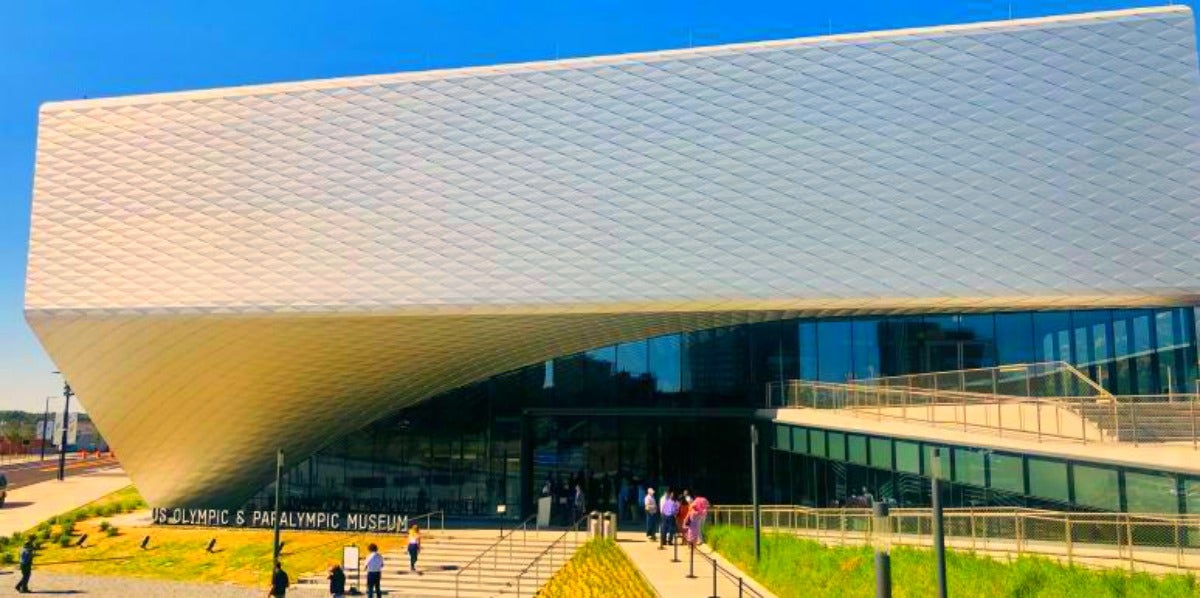 courtesy of the author
courtesy of the author Higher. Faster. Stronger.
This week, the much anticipated US Olympic and Paralympic Museum (USOPM) opened in downtown Colorado Springs. Designed by leading architects Diller Scafidio Renfro of New York City Lincoln Center and High Line fame, this 60,000 square foot building features 12 galleries which follow a narrative arc that takes guests on the journey of the modern Olympics and the athletes that have taken part in the games.
Before the museum was even completed it received praise from both Architectural Digest and the Smithsonian as one of the most anticipated buildings and museums of 2020, respectively.
With its cutting-edge design and technology capabilities, the US Olympic and Paralympic Museum is one of the most accessible and interactive in the world.
I have had an inside view to this project — 9 years in the making — as it is the brainchild of my husband, Dick Celeste.
We moved to Colorado Springs in 2002 for his job as President of Colorado College. He said almost immediately that Colorado Springs underleveraged its connection to the Olympics. The US Olympic Committee is headquartered here as well as many National Governing Bodies (NGB) and one of the largest Olympic Training Facilities in the country.
Upon retirement from the college in 2011, Dick began encouraging the community to build an Olympic Museum and Hall of Fame. He had been governor of Ohio and committed the first $5M of state money to build the Rock 'n Roll Hall of Fame in Cleveland and saw the transformational impact it had on the city and especially the Lake Front.
The newly-elected mayor tapped him to get the project started. Almost a decade and $90M of locally-raised donor funds and state support later, the Museum was unveiled Thursday with the mayor’s successor, the Governor, Olympians, donors, community and board members and staff in attendance.
“From the very beginning we aimed to celebrate Paralympic as well as Olympic athletes,” Dick said.
“Therefore we aspired to make this the most accessible venue and experience in the nation, a goal I believe we achieved. We were helped by enthusiastic Paralympic athletes who were involved in every element of the project. Indeed, we have Paralympic medalists among our Guest Services staff as we welcomed our first visitors”
Originally scheduled to open ahead of and take advantage of the excitement around the Summer 2020 Olympic games in Tokyo, the US Olympic and Paralympic Museum had to adapt in light of the pandemic, which pushed this year's Olympics to Summer 2021, and opened with a smaller yet very enthusiastic (and properly masked and socially distanced) bang.
The stories of our Olympians and Paralympians are the stories of this nation’s history,” said Museum CEO Christopher Liedel. "Every American can see themselves in the members of Team USA and will be inspired by their dedication, perseverance and respect for the Olympic and Paralympic values. The Museum has the unique privilege of telling these stories, and we are ready and excited to share them with the world."
Team USA athletes have been involved and consulted throughout the process of design to achieve the goal of an authentic experience and inclusive design with the US Olympic and Paralympic Museum.
Kathleen Barrie of Barrie Projects curated the museum’s content and helped conduct charrettes with the athletes.
“We didn’t want to do one thing before we met with a group of athletes, coaches, trainers, and NGB’s asked them what should be in the museum. After only a few hours of discussion the 20 person group voiced unanimously that the important thing about the museum is that it be authentic.”
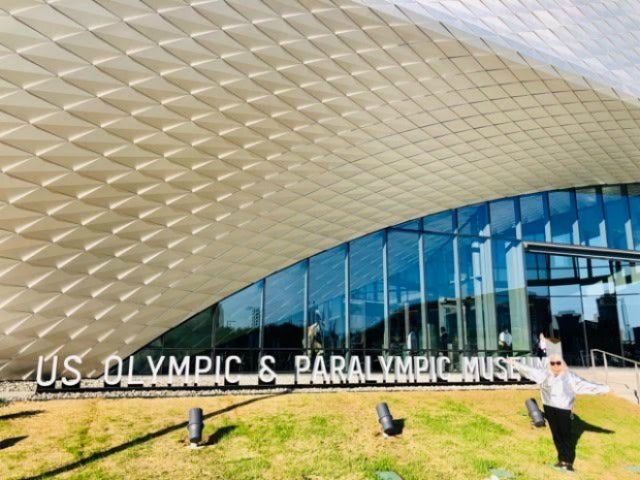
Kathleen Barrie at the opening of the US Olympic & Paralympic Museum, photo courtesy of Kathleen Barrie
Barrie is no stranger to museum curation, having helped design the ever popular and now expanded Spy Museum in Washington, DC and the Mob Museum in Las Vegas.
“We knew we got the Spy Museum right," she said with a smile, “when men in grey suits (read FBI agents from next door) experienced the exhibits and knowingly nodded to each other. As we talked to the athletes,” she continued, “the common thread was the story of their journeys to excellence. We just had to get that right!”
It took seven years of research and discovery to highlight the many stories of the athletes.
“Often you start and wonder if there is enough,” she recalled. “In this case, there was too much."
"US athletes have won over 5000 medals in 62 Olympic sports and 28 Paralympic sports. The total number of athletes is 12,174 and every one is represented. Telling the stories that not everyone already knows was paramount.”
Joey Cheek, a gold, silver and bronze winning speed skater recalled, “From the moment I became an Olympian, my world was changed. From the friends I made from countries around the globe to finally accomplishing my childhood dream of becoming the best in the world, there is something magical about that sporting festival we hold every two years.
"As incredible as it is [to experience the Olympics] on tv, only a tiny handful of people get to experience what it feels like to breathe that rarified air," Cheek told me.
Until now.
Joey was involved with the project from the beginning and serves on the board of the museum. “What the USOPM does for the people of Colorado and for visitors from around the country, is bring that fleeting, magical two weeks to life for everyone to experience. The Olympics changed me for the better in so many ways and I’m certain that visitors will come away inspired, and in some small way changed, by experiencing what it means to live life as an Olympian.”
Tamara (Jenkins) Cheek, Joey’s wife and a competitor in Sprint Kayak remarked, “The biggest thrill of the Olympic Games for me, was walking into the Olympic stadium for Opening Ceremony and representing not only my country, but all the people that had supported my journey to become an Olympian.
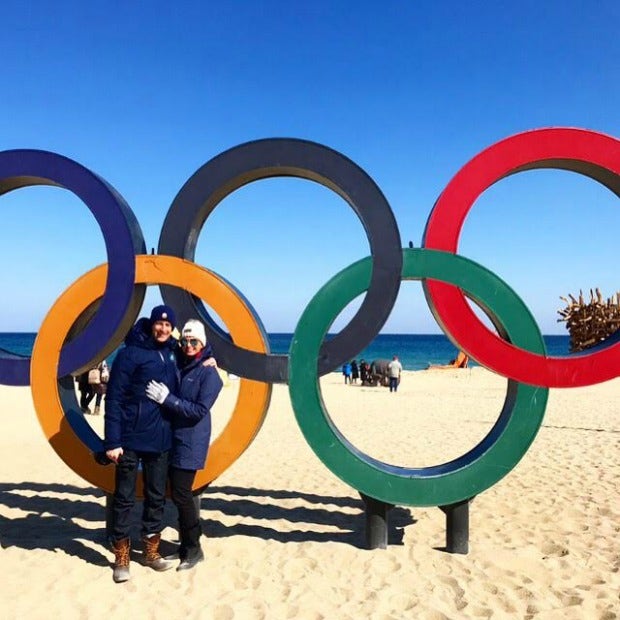
Tamara and Joey Cheek in Pyongyang
She continued, "As I walked into the stadium in Sydney 2000, my family, friends, teammates, and coaches walked with me in spirit. The most exciting thing about the museum is that now, everyone can experience that same feeling.
The first stop should by the Parade of Nations which was conceptualized by the Olympians and Paralympians involved with the design of the Museum to bring to life the joy and delight of walking in the Opening Ceremony of the Games.”
Benita Fitzgerald Mosley, a member of the museum’s board and a 1984 Gold Medalist in the 100 meter hurdles addressed the crowd at the opening.
“The Olympic ideals promote peace, friendship and understanding — and boy, couldn’t we use a bit more of that in this country and in the world right now?"
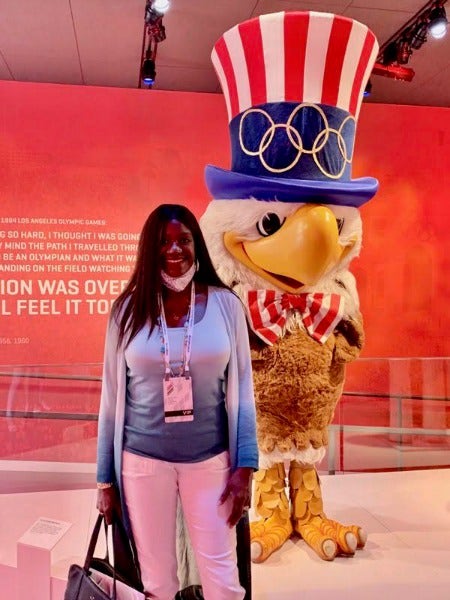
Benita Fitzgerald Mosley in front of the 1984 Olympic mascot
“During the ancient Olympic Games, beginning in 776 BC, warring nations honored what is called the ‘Olympic Truce’ whereby they would lay down their arms beginning seven days before the games got underway and ending seven days after them," she explained.
"The truce allowed athletes, artists, their families and ordinary pilgrims to travel to and from the games safely. Just as the Olympic Games have always served as a beacon of hope and peace for the world, I believe that this beautiful and iconic building will serve as a beacon of hope for this city, the state of Colorado and for the country.”
Fitzgerald Mosley added, “People ask me all the time, what did it feel like to compete in the games and win a medal. How did you train? What did you eat? Well, now, we finally have a place where others can see, experience and learn firsthand the answers to those questions and more! I hope they will be inspired to Go for the Gold in their own lives, both literally and figuratively.”
John Register, a gifted All-American University of Arkansas track star who had qualified for the Olympic trials in high hurdles was training one day in 1994 when he hyperextended his left knee on a landing and suffered an injury so severe that it led to the amputation of his leg.
After his injury, Register started to swim as part of the rehabilitation process. He qualified for the US Paralympic Swim Team and participated in the Paralympic Games in Atlanta in 1996.
Once fitted with the proper prosthesis, he began training for track and field events for the Sydney 2000 Paralympics and won a Silver Medal in long jump and took fifth in the 100 and 200-meter races. He has donated one of his prosthetic legs to the museum.
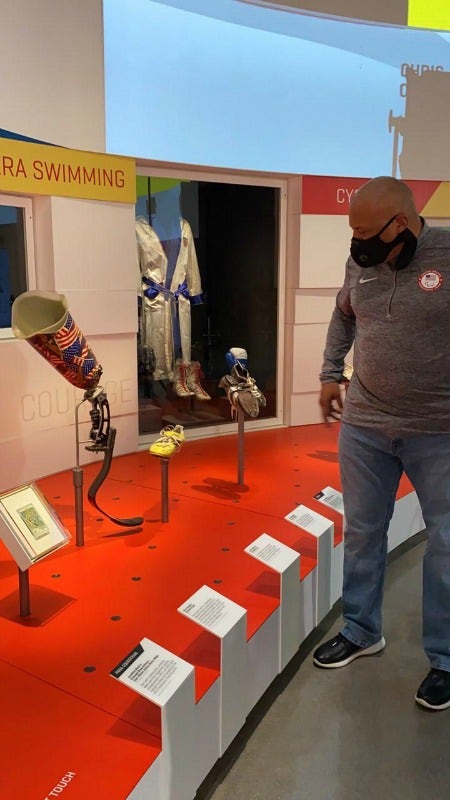
John Register in front of the display featuring his leg, photo by Ashley Register
“The Olympic mottos is Citius, Altius, Fortis,” he began at his speech Thursday. “Faster, Higher, Stronger. Those words are not written in the superlative of the word, Fastest, Highest or Strongest. They are written with that -ER stem ending because we can have our greatest performances today and be every greater tomorrow. We can be the swiftest today and be even faster tomorrow. We can jump the highest today and jump even higher tomorrow. We can be the strongest today and be even stronger tomorrow.”
“What you are going to find in this museum," he adds, “is not the destination of the athletes like me, but the journey and the legacies we get to leave.”
John pointed to a woman in the crowd. “That’s Melissa Stockwell. Bronze Medalist. Triathlon. Rio Games. Her journey started in Afghanistan where she was the first woman in combat to be injured and an amputee. Now she gets to have a home here,” he said pointing to the museum behind him. “We are side by side and it gives me goosebumps.”
“On this day in 1990, President George HW Bush signed the Americans With Disabilities Act into law,’ he continued, “but 30 years later we still have attitudinal barriers."
"For me, what this museum represents is that everyone is included. This museum is where dreams rise. This museum is where resilience resides," he said.
"This is where the power of sport connects the world and is immortalized for the human spirit. This is what I saw when I saw my leg displayed in the summer sports hall. When you go through the museum remember these words ‘Go Forth — Inspire Your World.’ 'Go!' is your command. 'Forth' is your direction. 'Inspire' is your vocation. 'Your' because its your DNA, its personal to you. And 'world' because this is your sphere of influence. Go forth and inspire your world!”
The US Olympic and Paralympic Museum's accessibility to all visitors is foundational to its mission.
Guests can customize their sport preference and accessibility needs for a tour that is uniquely their own. As I toured the building, the interactive kiosks would welcome me by name, recognized my sporting preference and change their content for my interest.
As Kathleen Barrie pointed out after touring the museum and seeing the final project yesterday, “There are so many ways to look at this museum. There is a mix of elements that appeals to different audiences. The architecture is remarkable and some people will just come to see the structure. For others , it is about the Olympics and for even others it is the accessibility factor. For me, I was looking at the artifacts I worked on and to see how they landed.”
General admission tickets are now available with prices ranging from $14.95 to $24.95. Membership tickets are available on the museum's website.
Working in concert with the El Paso County Health Director, tickets sales are based on timed entry for strictly enforced social distancing guidelines and masks are required at all times.
Jacqueline Lundquist is an author of several books, a former CBS entertainment reporter, former First Lady of the US in India where her husband served as the Ambassador. She is also the proud mother of a son who is a recent graduate of USC Film School. Follow her on Facebook and on Instagram, @jrlundquist.

